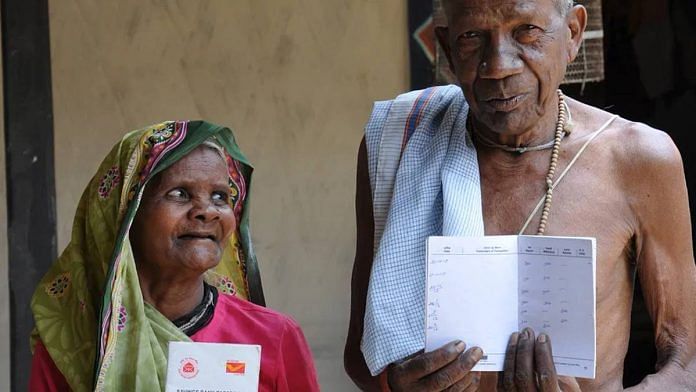New Delhi: Between 2017 and 2021, as many as 2,103 beneficiaries of the Centre’s social assistance schemes were given pensions even after they had died, a report of the Comptroller and Auditor General (CAG) of India, tabled in Parliament Tuesday, has shown. ThePrint has a copy of the report.
This is one of the many glaring lapses pointed out by CAG in its performance audit of the National Social Assistance Programme (NSAP). The scheme is aimed at providing basic financial support to old people, widows and disabled people who are below the poverty line.
The auditor observed that the death of beneficiaries was “not being reported by Gram Panchayats/municipalities in a timely manner”. Of the 2,103 people who were given pension even after their death, the maximum number — 453 cases — were from West Bengal, followed by 413 in Gujarat and 250 in Tripura.
In a 122-page report, the government auditor recommended “specific measures for cleaning/weeding out ineligible beneficiaries, stopping of pension after the death of beneficiaries and verification/authentication of beneficiary data may be instituted”.
Under the NSAP, which is implemented by the rural development ministry, monthly pension is provided under three sub-schemes, namely the Indira Gandhi National Old Age Pension Scheme (IGNOAPS), Indira Gandhi National Widow Pension Scheme (IGNWPS), and Indira Gandhi National Disability Pension Scheme (IGNDPS).
According to the CAG report, NSAP schemes reached an average 2.83 crore beneficiaries annually between 2017 and 2021. Additionally, 1.82 crore beneficiaries were covered by similar state and UT schemes. While the Centre allocated Rs 34,432 crore for NSAP during this period, states and UTs too allocated an additional 1,09,573 crore for similar schemes.
The national auditor also pointed at issues of states and UTs not transferring funds for the schemes to implementing departments on time, despite receiving it from the Centre.
Also read: CAG audit into renovation of Kejriwal’s residence: L-G office takes credit, AAP calls it drama
Disbursal to ‘ineligible’ beneficiaries
Under IGNOAPS, a monthly old age pension for those above the age of 60 years, an amount of Rs 200 per month is given to those between the age of 60-79 years and Rs 500 for those aged 80 years and above.
“In 14 states/UTs, IGNOAPS pension of Rs 30.47 crore was paid to 57,394 ineligible persons who were less than 60 years of age,” the report said. The maximum number of such cases — 29,856 — were reported from Chandigarh, followed by 16,724 from Andhra Pradesh.
In some states and Union Territories, such as Bihar, Telangana, Ladakh and Jharkhand, women who were not widows or even male family members were paid widow pensions, according to the CAG report. According to the criteria under IGNWPS, widow beneficiaries of the scheme should be above 40 years of age.
“In 17 States/UTs, IGNWPS pension of Rs 26.45 crore was paid to 38,540 ineligible persons who were less than 40 years of age,” the report stated.
Similarly, in 12 states and UTs, disability pension of 4.36 crore under the IGNDPS scheme was paid to 5,380 ineligible people, who were less than 18 years of age, said the report, adding that according to the age criteria under IGNDPS the beneficiary should be above 18 years of age.
“In 16 States/UTs, IGNDPS pension of Rs 15.11 crore was paid to 21,322 persons whose disability was either below 80 per cent or could not be ascertained,” the report said.
Funds diverted or lying unused for years
Pointing at the lack of financial monitoring on the part of states and UTs, the auditor said, “Rs 18.78 crore were lying idle in eight states for a period ranging from one to five years. Idling of funds at State/District level indicates that the reporting of financial positions by Districts is not being ensured. The reasons for idling of funds were such as release of funds at the fag end of the financial year, non-revalidation of funds from administrative department, duplication and non-permissible age limit of the beneficiaries.”
The report also pointed at delay in timely disbursement of pension to beneficiaries.
“System-based checks may be instituted to avoid overpayment, short payment, multiple payment and delays in payment of pension. Pension may be paid on a monthly basis through a bank/post office account integrated with Aadhaar/biometric authentication. A mechanism for reviewing cases of irregular pension payments and fixing of responsibility on such cases may be instituted,” the CAG recommended.
The report further said that the monitoring and evaluation was not done as envisaged at state and Union Territory level owing to the non-existence of state-level committees in 30 states and UTs. The report stated that under NSAP guidelines, states were to constitute state-level committees for the implementation and monitoring of the various schemes.
“Monitoring by various committees, National Level Monitors, periodical evaluation studies and action on the findings thereof may be ensured. Robust social audit and grievance redressal mechanisms may be established for ensuring transparency and accountability,” recommended the CAG in its report.
(Edited by Poulomi Banerjee)



